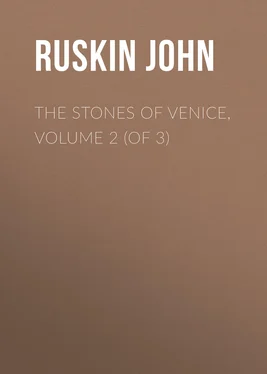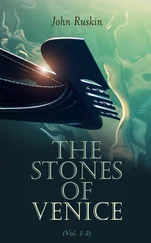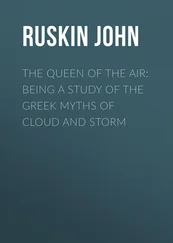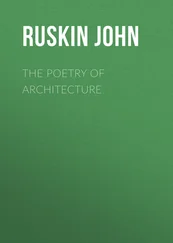John Ruskin - The Stones of Venice, Volume 2 (of 3)
Здесь есть возможность читать онлайн «John Ruskin - The Stones of Venice, Volume 2 (of 3)» — ознакомительный отрывок электронной книги совершенно бесплатно, а после прочтения отрывка купить полную версию. В некоторых случаях можно слушать аудио, скачать через торрент в формате fb2 и присутствует краткое содержание. Жанр: foreign_antique, foreign_home, architecture_book, literature_19, visual_arts, на английском языке. Описание произведения, (предисловие) а так же отзывы посетителей доступны на портале библиотеки ЛибКат.
- Название:The Stones of Venice, Volume 2 (of 3)
- Автор:
- Жанр:
- Год:неизвестен
- ISBN:нет данных
- Рейтинг книги:5 / 5. Голосов: 1
-
Избранное:Добавить в избранное
- Отзывы:
-
Ваша оценка:
- 100
- 1
- 2
- 3
- 4
- 5
The Stones of Venice, Volume 2 (of 3): краткое содержание, описание и аннотация
Предлагаем к чтению аннотацию, описание, краткое содержание или предисловие (зависит от того, что написал сам автор книги «The Stones of Venice, Volume 2 (of 3)»). Если вы не нашли необходимую информацию о книге — напишите в комментариях, мы постараемся отыскать её.
The Stones of Venice, Volume 2 (of 3) — читать онлайн ознакомительный отрывок
Ниже представлен текст книги, разбитый по страницам. Система сохранения места последней прочитанной страницы, позволяет с удобством читать онлайн бесплатно книгу «The Stones of Venice, Volume 2 (of 3)», без необходимости каждый раз заново искать на чём Вы остановились. Поставьте закладку, и сможете в любой момент перейти на страницу, на которой закончили чтение.
Интервал:
Закладка:
CHAPTER IV.
ST. MARK’S
§ I. “And so Barnabas took Mark, and sailed unto Cyprus.” If as the shores of Asia lessened upon his sight, the spirit of prophecy had entered into the heart of the weak disciple who had turned back when his hand was on the plough, and who had been judged, by the chiefest of Christ’s captains, unworthy thenceforward to go forth with him to the work, 19how wonderful would he have thought it, that by the lion symbol in future ages he was to be represented among men! how woful, that the war-cry of his name should so often reanimate the rage of the soldier, on those very plains where he himself had failed in the courage of the Christian, and so often dye with fruitless blood that very Cypriot Sea, over whose waves, in repentance and shame, he was following the Son of Consolation!
§ II. That the Venetians possessed themselves of his body in the ninth century, there appears no sufficient reason to doubt, nor that it was principally in consequence of their having done so, that they chose him for their patron saint. There exists, however, a tradition that before he went into Egypt he had founded the Church at Aquileia, and was thus, in some sort, the first bishop of the Venetian isles and people. I believe that this tradition stands on nearly as good grounds as that of St. Peter having been the first bishop of Rome; 20but, as usual, it is enriched by various later additions and embellishments, much resembling the stories told respecting the church of Murano. Thus we find it recorded by the Santo Padre who compiled the “Vite de’ Santi spettanti alle Chiese di Venezia,” 21that “St. Mark having seen the people of Aquileia well grounded in religion, and being called to Rome by St. Peter, before setting off took with him the holy bishop Hermagoras, and went in a small boat to the marshes of Venice. There were at that period some houses built upon a certain high bank called Rialto, and the boat being driven by the wind was anchored in a marshy place, when St. Mark, snatched into ecstasy, heard the voice of an angel saying to him: ‘Peace be to thee, Mark; here shall thy body rest.’” The angel goes on to foretell the building of “una stupenda, ne più veduta Città;” but the fable is hardly ingenious enough to deserve farther relation.
§ III. But whether St. Mark was first bishop of Aquileia or not, St. Theodore was the first patron of the city; nor can he yet be considered as having entirely abdicated his early right, as his statue, standing on a crocodile, still companions the winged lion on the opposing pillar of the piazzetta. A church erected to this Saint is said to have occupied, before the ninth century, the site of St. Mark’s; and the traveller, dazzled by the brilliancy of the great square, ought not to leave it without endeavoring to imagine its aspect in that early time, when it was a green field cloister-like and quiet, 22divided by a small canal, with a line of trees on each side; and extending between the two churches of St. Theodore and St. Geminian, as the little piazza of Torcello lies between its “palazzo” and cathedral.
§ IV. But in the year 813, when the seat of government was finally removed to the Rialto, a Ducal Palace, built on the spot where the present one stands, with a Ducal Chapel beside it, 23gave a very different character to the Square of St. Mark; and fifteen years later, the acquisition of the body of the Saint, and its deposition in the Ducal Chapel, perhaps not yet completed, occasioned the investiture of that chapel with all possible splendor. St. Theodore was deposed from his patronship, and his church destroyed, to make room for the aggrandizement of the one attached to the Ducal Palace, and thenceforward known as “St. Mark’s.” 24
§ V. This first church was however destroyed by fire, when the Ducal Palace was burned in the revolt against Candiano, in 976. It was partly rebuilt by his successor, Pietro Orseolo, on a larger scale; and, with the assistance of Byzantine architects, the fabric was carried on under successive Doges for nearly a hundred years; the main building being completed in 1071, but its incrustation with marble not till considerably later. It was consecrated on the 8th of October, 1085, 25according to Sansovino and the author of the “Chiesa Ducale di S. Marco,” in 1094 according to Lazari, but certainly between 1084 and 1096, those years being the limits of the reign of Vital Falier; I incline to the supposition that it was soon after his accession to the throne in 1085, though Sansovino writes, by mistake, Ordelafo instead of Vital Falier. But, at all events, before the close of the eleventh century the great consecration of the church took place. It was again injured by fire in 1106, but repaired; and from that time to the fall of Venice there was probably no Doge who did not in some slight degree embellish or alter the fabric, so that few parts of it can be pronounced boldly to be of any given date. Two periods of interference are, however, notable above the rest: the first, that in which the Gothic school, had superseded the Byzantine towards the close of the fourteenth century, when the pinnacles, upper archivolts, and window traceries were added to the exterior, and the great screen, with various chapels and tabernacle-work, to the interior; the second, when the Renaissance school superseded the Gothic, and the pupils of Titian and Tintoret substituted, over one half of the church, their own compositions for the Greek mosaics with which it was originally decorated; 26happily, though with no good will, having left enough to enable us to imagine and lament what they destroyed. Of this irreparable loss we shall have more to say hereafter; meantime, I wish only to fix in the reader’s mind the succession of periods of alteration as firmly and simply as possible.
§ VI. We have seen that the main body of the church may be broadly stated to be of the eleventh century, the Gothic additions of the fourteenth, and the restored mosaics of the seventeenth. There is no difficulty in distinguishing at a glance the Gothic portions from the Byzantine; but there is considerable difficulty in ascertaining how long, during the course of the twelfth and thirteenth centuries, additions were made to the Byzantine church, which cannot be easily distinguished from the work of the eleventh century, being purposely executed in the same manner. Two of the most important pieces of evidence on this point are, a mosaic in the south transept, and another over the northern door of the façade; the first representing the interior, the second the exterior, of the ancient church.
§ VII. It has just been stated that the existing building was consecrated by the Doge Vital Falier. A peculiar solemnity was given to that act of consecration, in the minds of the Venetian people, by what appears to have been one of the best arranged and most successful impostures ever attempted by the clergy of the Romish church. The body of St. Mark had, without doubt, perished in the conflagration of 976; but the revenues of the church depended too much upon the devotion excited by these relics to permit the confession of their loss. The following is the account given by Corner, and believed to this day by the Venetians, of the pretended miracle by which it was concealed.
“After the repairs undertaken by the Doge Orseolo, the place in which the body of the holy Evangelist rested had been altogether forgotten; so that the Doge Vital Falier was entirely ignorant of the place of the venerable deposit. This was no light affliction, not only to the pious Doge, but to all the citizens and people; so that at last, moved by confidence in the Divine mercy, they determined to implore, with prayer and fasting, the manifestation of so great a treasure, which did not now depend upon any human effort. A general fast being therefore proclaimed, and a solemn procession appointed for the 25th day of June, while the people assembled in the church interceded with God in fervent prayers for the desired boon, they beheld, with as much amazement as joy, a slight shaking in the marbles of a pillar (near the place where the altar of the Cross is now), which, presently falling to the earth, exposed to the view of the rejoicing people the chest of bronze in which the body of the Evangelist was laid.”
Читать дальшеИнтервал:
Закладка:
Похожие книги на «The Stones of Venice, Volume 2 (of 3)»
Представляем Вашему вниманию похожие книги на «The Stones of Venice, Volume 2 (of 3)» списком для выбора. Мы отобрали схожую по названию и смыслу литературу в надежде предоставить читателям больше вариантов отыскать новые, интересные, ещё непрочитанные произведения.
Обсуждение, отзывы о книге «The Stones of Venice, Volume 2 (of 3)» и просто собственные мнения читателей. Оставьте ваши комментарии, напишите, что Вы думаете о произведении, его смысле или главных героях. Укажите что конкретно понравилось, а что нет, и почему Вы так считаете.












